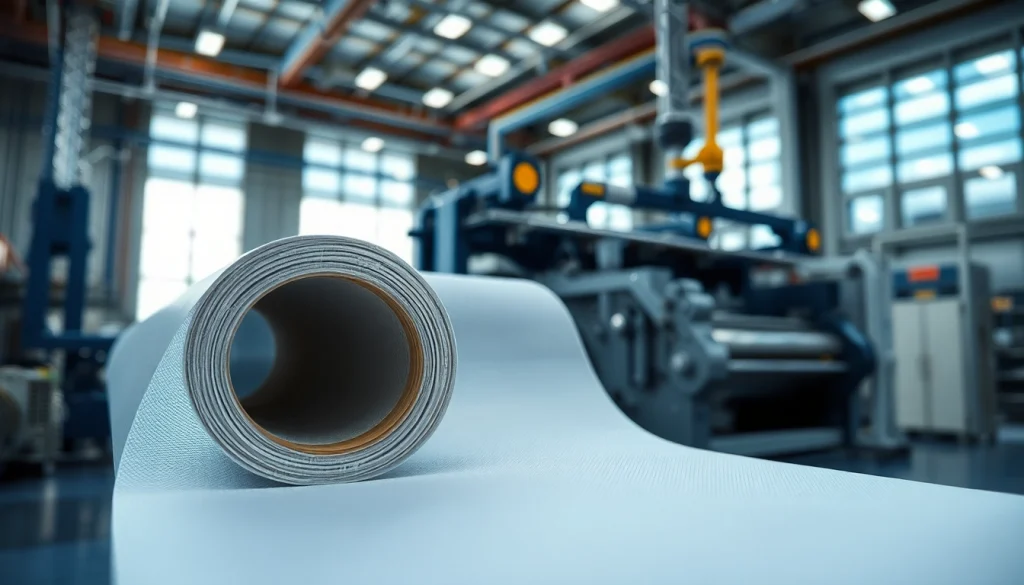Innovative Applications of Epoxy Prepregs in Advanced Manufacturing

Understanding Epoxy Prepregs
In the ever-evolving landscape of advanced manufacturing and composite materials, epoxy prepregs have emerged as a pivotal component across diverse industries. These materials combine reinforcing fibers with a resin system, establishing a robust foundation for making high-performance composite components. With their unique properties and advantages, epoxy prepregs are paving the way for innovative applications and solutions in various sectors, including aerospace, automotive, and sporting goods. This article dives deep into the world of epoxy prepregs by exploring their definitions, advantages, usage in various industries, best practices, and future trends.
What Are Epoxy Prepregs?
Epoxy prepregs are composite materials manufactured with reinforcing fibers—typically carbon fiber or fiberglass—that have been pre-impregnated with a cured epoxy resin matrix. This process reduces the amount of resin that needs to be mixed and applied during manufacturing, leading to a more controlled and uniform product. The term “prepreg” aptly describes the initial state of these composite materials, which are designed for easy processing while ensuring consistent quality and performance.
The prepreg material’s base, the epoxy resin, typically undergoes partial curing before being combined with the fibers. This hybrid material allows for improved handling, extended shelf life at controlled temperatures, and a simplified manufacturing process compared to traditional methods. When subjected to heat and pressure, the matrix fully cures, resulting in a strong, lightweight finished product that exhibits high mechanical and chemical resistance.
Key Properties of Epoxy Prepregs
Epoxy prepregs are characterized by several notable properties that contribute to their widespread use. These include:
- High Strength-to-Weight Ratio: Due to their structure and material composition, epoxy prepregs offer exceptional tensile strength while remaining lightweight.
- Low Shrinkage: The dimensional stability provided by prepregs during the curing process minimizes warping and distortion, ensuring consistency in structural integrity.
- Superior Adhesion: The chemical properties of epoxy resin facilitate excellent bonding with various substrates, allowing for robust composite structures.
- Resistance to Environmental Factors: Epoxy prepregs exhibit excellent resistance to moisture, chemicals, and UV light, making them suitable for demanding applications.
- Thermal Stability: These materials maintain their mechanical properties under a wide range of temperature conditions, appealing for automotive and aerospace applications.
Common Materials Used in Epoxy Prepregs
The composition of epoxy prepregs is crucial to their performance. Common materials in their construction include:
- Carbon Fiber: Known for its high strength-to-weight ratio, carbon fiber is often used in aerospace and high-performance automotive applications.
- Glass Fiber: A more cost-effective alternative to carbon fiber, glass fiber boasts decent mechanical properties while also being highly versatile.
- Hybrid Composites: These can combine different fibers to leverage the strengths of each material, offering tailored performance for specific applications.
Advantages of Epoxy Prepregs
Performance Benefits in Manufacturing
Utilizing epoxy prepregs in manufacturing presents numerous performance advantages. First and foremost, these materials offer exceptional mechanical properties that contribute to the strength and durability of finished products. Compared to traditionally molded composites, epoxy prepregs allow for more precise control over the material distribution, resulting in stronger bonds and less waste during the production process.
Another performance benefit is their compatibility with automated manufacturing processes, such as automated fiber placement (AFP) and automated tape laying (ATL). The ability to pre-align fibers ensures uniformity and repeatability in production, optimizing efficiency and reducing labor costs. This unique combination of properties helps manufacturers meet stringent quality standards while adhering to stricter regulatory compliance.
Cost-Effectiveness Compared to Alternative Materials
When evaluating cost-effectiveness, epoxy prepregs exhibit a competitive advantage over traditional materials. Although the initial material cost may be higher, the overall cost efficiency can be significantly enhanced owing to factors such as reduced labor time, decreased scrap rates, and improved production throughput. The precise formulation of these prepregs allows for optimal material utilization—reducing waste and ensuring that every cut or layer contributes to the final product.
Moreover, epoxy prepregs minimize post-curing processing, thus accelerating production times and decreasing labor requirements. This results in a lower cost per unit in high-volume applications. Additionally, the durability and longevity of the resulting components can lead to savings through reduced maintenance and replacement costs in the long run.
Environmental Considerations of Epoxy Prepregs
As the manufacturing industry faces increasing scrutiny concerning its environmental impact, epoxy prepregs contribute to more sustainable practices. Many manufacturers are exploring the use of renewable resources and bio-based epoxy resins that minimize the reliance on traditional petrochemicals. The inherent lower emissions associated with the production of epoxy prepregs further support sustainability initiatives across industries.
Furthermore, epoxy prepregs offer recyclability benefits, as many composite products can be repurposed into new materials or components. This circular economy approach helps manufacturers meet environmental regulations while promoting responsible consumption and production practices.
Industries that Utilize Epoxy Prepregs
Aerospace and Defense Applications
The aerospace and defense industries have been pioneers in the adoption of epoxy prepregs. Components such as aircraft wings, fuselage sections, and support structures benefit from the lightweight yet strong nature of these materials, enhancing fuel efficiency while maintaining structural integrity. The ability to create complex geometries through processes like resin transfer molding (RTM) and vacuum bagging further allows designers and engineers to innovate continuously.
Additionally, epoxy prepregs offer high thermal and chemical resistance, ensuring that components endure harsh environments without compromising strength. The reliability of these materials is paramount in aerospace applications, as performance standards require rigorous testing and validation protocols.
Automotive and Transportation Sectors
In the automotive sector, manufacturers are increasingly implementing epoxy prepregs to reduce vehicle weight and improve fuel efficiency. Components such as structural reinforcements, body panels, and high-performance parts—such as hoods and roofs—benefit from the properties of these composite materials.
The manufacturing processes enabled by epoxy prepregs, such as automated fiber placement, allow for complex part geometries that traditional materials cannot achieve efficiently. This has led to advancements in safety features and performance enhancements while remaining compliant with increasingly stringent emissions regulations.
Sports Equipment Manufacturing
The sporting goods industry utilizes epoxy prepregs for high-performance and lightweight equipment, including bicycles, golf clubs, tennis rackets, and more. The combination of strength, durability, and weight reduction makes epoxy prepregs the material of choice for elite athletes and enthusiasts who seek performance advantages.
In this sector, ongoing research and development efforts strive to enhance material performance even further, leading to innovations such as improved impact resistance and customized flexibility to meet the unique needs of athletes across various sports domains.
Best Practices for Working with Epoxy Prepregs
Storage and Handling Guidelines
To maximize the lifespan and performance of epoxy prepregs, adhering to appropriate storage and handling practices is crucial. These materials should be stored in a cool, dry environment, ideally in a controlled temperature range, typically between 0°C to 10°C, to prevent premature curing.
When handling epoxy prepregs, always use proper personal protective equipment (PPE) and ensure workspaces are adequately ventilated to mitigate exposure to fumes. It’s also essential to limit the time prepregs are exposed to room temperature before use, as extended exposure can lead to a reduction in tack and adhesive properties.
Curing Process Techniques
Understanding the curing process is critical for achieving optimal performance from epoxy prepregs. The curing of epoxy resin involves applying heat and pressure, which activates the chemical cross-linking process. There are several methods for curing prepregs, including:
- Autoclave Curing: This traditional method utilizes pressure and temperature in a controlled environment, providing uniform heat distribution and allowing for high-quality parts.
- Oven Curing: Suitable for small-scale production, oven curing provides a simpler and cost-effective method while maintaining consistent thermal conditions.
- Out-of-Autoclave (OoA) Methods: Emerging technologies such as vacuum bagging and resin infusion enable manufacturers to use lower-cost equipment while still achieving reliable results.
Quality Control Measures
Implementing stringent quality control measures is vital at every stage of using epoxy prepregs. Key practices include:
- Material Inspection: Conduct thorough inspections to ensure that fiber orientation, resin content, and material integrity meet specifications before manufacturing begins.
- Process Monitoring: Establish parameters for temperatures, pressures, and curing times during processing to ensure optimal conditions.
- Final Product Testing: Assess finished components through destructive and non-destructive tests (NDT) to evaluate performance criteria such as tensile strength, impact resistance, and dimensional accuracy.
The Future of Epoxy Prepregs in Manufacturing
Emerging Trends and Innovations
As the demand for lightweight, strong, and sustainable materials continues to grow, epoxy prepregs will see further innovations in both formulation and application. Researchers are exploring hybrid resins that incorporate advanced materials, aiming to create even stronger yet lighter composites. Developments such as textile reinforcements and advanced curing systems enhance the capabilities of these prepregs, making them suitable for increasingly complex applications.
Research and Development in Epoxy Materials
The field of epoxy materials is experiencing significant research efforts aimed at enhancing performance characteristics while optimizing eco-friendliness. Investigations into bio-based epoxy resins are gaining traction, assisting in reducing reliance on petrochemical sources and improving the sustainability profile of composites. The integration of smart materials—such as those capable of self-healing or exhibiting variable stiffness—mark the next frontier, expanding the versatility of epoxy prepregs.
Expanding Applications Across Industries
The versatility of epoxy prepregs positions them for an expanding range of applications beyond traditional sectors. Fields such as renewable energy, where composite materials are utilized in wind turbine blades, and construction, where they are applied in lightweight yet strong structural elements, showcase the broad potential for epoxy prepregs.
As industries continue to evolve, the adaptability and performance of epoxy prepregs will play a critical role in enabling innovative solutions to meet future challenges. By staying ahead of trends, manufacturers and engineers can leverage the unique attributes of epoxy prepregs to create next-generation products that redefine standards in quality, sustainability, and performance.







